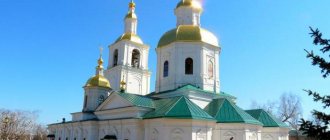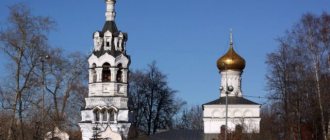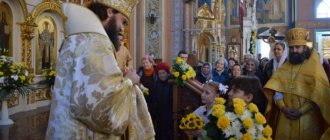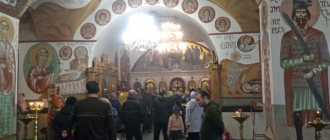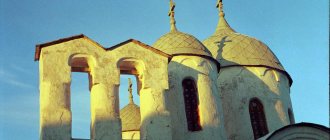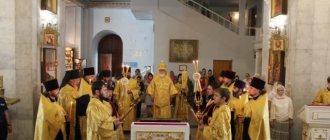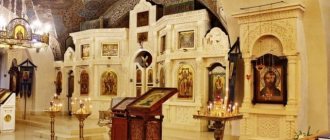Mir
Temple of Elijah the Prophet (Ilyinka) Map is loading...
{"format":"leaflet","minzoom":false,"maxzoom":false,"limit":50,"offset":0,"link":"all","sort":[""], "order":[],"headers":"show","mainlabel":"","intro":"","outro":"","searchlabel":"\u2026 \u0441\u043b\u0435\ u0434\u0443\u044e\u0449\u0438\u0435 \u0440\u0435\u0437\u0443\u043b\u044c\u0442\u0430\u0442\u044b","default":"","import-annotation":false,"width ":"auto","height":"350px","centre":{"text":"","title":"""link":"""lat":55.4493020000000029767761589027941226959228515625,"lon": 69.32580699999999751526047475636005401611328125,"icon":""},"title":"","label":"","icon":"","lines":[],"polygons":[], "circles":[ ],"rectangles":[],"copycoords":false,"static":false,"zoom":8,"defzoom":14,"layers":["OpenStreetMap"],"image layers":[] ,"overlays":[],"resizable":false,"fullscreen":true,"scrollwheelzoom":true,"cluster":false,"clustermaxzoom":9,"clusterzoomonclick":true,"clustermaxradius":80, "clusterspiderfy":true,"geojson":"","clicktarget":"","showtitle":true,"hidenamespace":false,"template":"","userparam":"","activeicon": "","pagelabel":false,"ajaxcoordproperty":"","ajaxquery":"","locations":[{"text":"\u003Cb\u003E\u003Ca href=\"/palomnik/%D0% A5%D1%80%D0%B0%D0%BC_%D0%98%D0%BB%D0%B8%D0%B8_%D0%9F%D1%80%D0%BE%D1%80%D0%BE% D0%BA%D0%B0_(%D0%98%D0%BB%D1%8C%D0%B8%D0%BD%D0%BA%D0%B0)\» title=\»\u0425\u0440\u0430\ u043c \u0418\u043b\u0438\u0438 \u041f\u0440\u043e\u0440\u043e\u043a\u0430 (\u0418\u043b\u044c\u0438\u043d\u043a\u0430)\»\u003 E\u0425\u0440\u0430\ u043c \u0418\u043b\u0438\u0438 \u041f\u0440\u043e\u0440\u043e\u043a\u0430 (\u0418\u043b\u044c\u0438\u043d\u043a\u0430)\u003C/ a\u003E\u003C/b\ u003E\u003Chr /\u003E\u003Ca href=\»/palomnik/%D0%A1%D0%B2%D0%BE%D0%B9%D1%81%D1%82%D0%B2%D0%BE:%D0 %90%D0%BD%D0%BD%D0%BE%D1%82%D0%B0%D1%86%D0%B8%D1%8F\" title=\"\u0421\u0432\u043e\u0439\u0441 \u0442\u0432\u043e:\u0410\u043d\u043d\u043e\u0442\u0430\u0446\u0438\u044f\»\u003E\u0410\u043d\u043d\u043e\u0442\u0430\u0446 \u0438\u044f\u003C/ a\u003E: \u043f\u043e\u0441\u0442\u0440\u043e\u0435\u043d \u0432 1814 \u0433\u043e\u0434\u0443, \u0431\u044b\u043b \u0437\u0 430\u043a\u0440\u044b\u0442 \u0432 1935, \u043e\u0442\u043a\u0440\u044b\u0442 \u0432 1944 \u0438 \u0441\u043d\u043e\u0432\u0430 \u0437\u0430\u043a\u044 0\u044b\u0442 \u0432 1960. \u0412 \ u0437\u0434\u0430\u043d\u0438\u0438 \u0440\u0430\u0437\u043c\u0435\u0449\u0430\u043b\u0441\u044f \u043c\u0443\u0437\u0435\u0 439. 1990 1990 u043c,\u043e\u0442\u0440\u0435 \u0441\u0442\u0430\u0432\u0440\u0438\u0440\u043e\u0432\u0430\u043d.","title":"\u0425\u0440\u0430\u043c \u0418\u043b\u0438\u0438 \u041f\u0440 \u043e\u0440\u043e\u043a\u0430 (\u0418\u043b\u044c\u0438\u043d\u043a\u0430)”,”link”:”””lat”:55.44930200000000297677615890279412269 59228515625,"lon":69.32580699999999751526047475636005401611328125,"icon" :""}],"imageLayers":[]}
Address:
Tyumen region, Kazan district, Ilyinka village, st. Lenina, 15 a.
Temple of Elijah the Prophet
built in 1814, closed in 1935, reopened in 1944 and closed again in 1960. The building housed a museum. In 1990, it was handed over to believers and restored.
History[edit]
Ilyinsky Temple was built in 1814, one of the first stone churches in the Ishim region.
It was closed in 1935 and the building was used as a grain warehouse.
On June 7, 1944, by resolution of the Omsk Regional Executive Committee, the petition of believers to open the temple was granted.
In 1960, the temple was closed again, the building was used for household needs, and since the late 1970s it has been empty and destroyed.
Restoration by the collective farm began in 1985; the building housed a rural local history museum.
In 1990, the temple was handed over to believers. Restored and consecrated in 1996, bells were installed.
From the history of Elias Church
The Elias Shrine suffered more than once in fires, which often happened in Moscow. However, the church was always rebuilt after the next test.
The stone monastery stood on one of the busiest streets in the city. The arrival of foreign ambassadors, the announcement of royal decrees, active trade, where all of Moscow gathered - the shrine witnessed many events.
During the Time of Troubles, the alarm signal for an uprising was given from the bell tower of the Church of the Prophet Elijah on Ilyinka Street (in history this is the famous uprising of Muscovites in 1606).
In 1771, a plague epidemic that broke out in Moscow killed many parishioners of the temple.
When the priest died, there was simply no one to serve in the church, so the temple was sealed for some time. With the arrival of a new priest, the parish did not exist for long.
In the 60s of the 18th century, the buildings of the Novgorod courtyard, which included the Elijah Church, were rented by the merchant Pastukhov.
Soon the clergy began to complain about the indecent behavior of the tenant in relation to the shrine (an unpleasant smell was constantly coming from the tavern built nearby, as well as screaming, music and songs, which interfered with the life of the religious building). However, the decision of the Synod was unexpected - the clergy was advised to look for another place.
Since 1779, the temple of the prophet Elijah became a brownie.
In 1812 the building was damaged by fire. After 5 years it was completely restored.
History of the temple
History of the Temple of Elijah the Prophet in Lemeshevo.
The foundation of the temple. Temple before the October revolution.
In 1627, on the banks of the river. Pakhra, where Lemeshovo is located in our time, stood the village of Almeshovo, in which there were 4 courtyards. She, along with the Dubrovitsy, Erin and Alexandrov, was part of the large estate of the boyar family of the Morozovs.
The exact date of the founding of the first wooden temple of Elijah the Prophet is unknown, but the first written mention of the temple dates back to 1627. On the pages of the census books of the Przemysl church tithe there is the following entry: “...belonging to the boyar Ivan Vasilyevich Morozov, an ancient patrimony, the village of Dubrovitsy on the Pakhra River, the mouth of the river Desna, and in the village the church of Elijah the Prophet is made of wood, and in the church there are images, and books, and candles, and on the bell tower there are bells, and every church building is from the votchinnik; near the church in the yard there is priest Ivan Fedorov, in the yard there is a sexton and a mallow maker; the arable land of the church land is 10 in a field, and in two, 20 kopecks of hay..."
In 1662, at the request of the spouses Aksinya Ivanovna and Ivan Andreevich Golitsyn, a new wooden church with the same dedication was built in Dubrovitsy. It stood in the village until the summer of 1690, when, on the orders of Tsar Peter I, it was dismantled and moved to the village of Lemeshovo.
Coat of arms of the princes Golitsyn.
After the death of Prince Boris Alekseevich Golitsyn in 1714, Lemeshovo came into the possession of the widow of his eldest son Alexei, Anna Ivanovna, née Sukina, and their eldest son Sergei. At the age of 16, Prince Sergei Alekseevich Golitsyn (1695-1758) married Princess Anastasia Vasilievna Tolochanova. They lived together for 45 years and had two sons and four daughters. Prince Sergei Alekseevich was appointed a member of the Coin Chancellery in Moscow in 1735, received the rank of Privy Councilor in 1743, and became Moscow governor in 1753.
In the same year, by his order, the wooden Elijah Church was replaced by a stone one, or rather, a brick one, with white stone details in the Baroque style (corner pilasters, strip platbands and profile cornices). This church, located on the high bank of the river. Pakhra, successfully fit into the surrounding landscape. In plan, the building is a quadrangle, covered with a closed octagonal vault and expanded with rectangular extensions of the altar and vestibules. The altar is connected to the temple and chapels by arched spans. On the western side, a low two-tier bell tower adjoins the temple. The ascent to it is located in the thickness of the southern wall of the vestibule. The vaults of the altar and the vestibule are box-shaped with an end tray; in the lower tier of the half-tower there is a side vault. The church is completed with a small drum with a flattened head. The necks of the main volume and the bell tower are decorated with white stone currencies. The bell tower ends with a massive dome on a low tent. The openings of the upper tier of the bell tower are decorated with a balustrade. The planned structure of the Elias Church is similar to the structure of the church of the late 17th century, but the solution to the silhouette and space is fundamentally different.
Previously, the interior was painted, but the painting has not survived to this day, as well as the iconostasis. Here is its description, dated 1856: “The iconostasis is smooth, with small carvings, painted blue, gilded in places. The Royal Doors are carved and gilded. In the Royal Doors there are six picturesque icons: two of the Annunciation and four of the Evangelists... On the right side of the Royal Doors is a picturesque icon of the Savior, in a silvered copper robe with a gilded copper crown... The southern door to the holy altar... on it is a picturesque icon of the Archangel Gabriel. Next is the temple icon of the holy prophet Elijah, painted in a silvered copper robe with gilded crowns... On the left side of the Royal Doors is a picturesque icon of the Mother of God, called the “Unfading Color”, on it is a silvered copper robe with gilded copper crowns... The northern door to the holy altar... on it is a picturesque image of the Archangel Michael. Behind this door are the icons of St. Sergius, the Great Martyr Anastasia, Saints Nicholas and Alexis, picturesque, in a silvered copper robe and with gilded copper crowns... At the very top of the iconostasis, above the icon of the Lord of Savooth, is a wooden carved “Crucifixion with the Mother of God and John the Theologian” standing ..."
In the middle of the 19th century. warm (heated) temple with. Lemeshovo was considered a winter and cemetery church for the village. Dubrovits. In winter, services were performed in the Ilyinsky Church constantly, in the summer only during burial and commemoration of the dead. In 1850, priest John Georgievich Bulkin served in both churches.
In 1908, the clergy and elder of the Elias Church asked the Moscow Spiritual Consistory to allow the expansion of the temple by adding two side walls to it. The documents were transferred to the Imperial Archaeological Society, which requested photographs of the church. On July 25, 1908, the society made a decision of the following nature: “The reconstruction of the temple is not allowed, since it will disrupt the appearance of the temple, which is of artistic interest.” Priest Leonid Ilyinsky tried to correct the current situation and personally petitioned the Archaeological Society to rebuild the temple. A. M. Gurzhienko arrived in Lemeshevo to inspect the Ilyinskaya Church, who reported to the society that “... arches have been made in the northern and southern walls of the temple and the extension of the boundaries is already underway...”. As it turned out, the work was carried out with the consent of the Provincial Board under the supervision of the architect N. N. Blagoveshchensky, but without the permission of the Imperial Archaeological Council, which was a violation of the laws in force at that time. Nevertheless, thanks to the efforts of priest Leonid Ilyinsky, side chapels were added to the temple: one in honor of the icon of the Mother of God “Joy of All Who Sorrow”, and the other in the name of St. Sergius of Radonezh.
Temple after the October revolution.
In 1922, on the basis of a decree of the All-Russian Central Executive Committee, silver vestments from icons and silver jewelry with a total weight of 12 pounds were confiscated from the temple, as stated in the certificate of confiscation “to help the starving.” In 1937, on October 14, on the feast of the Intercession of the Mother of God, the rector of the church, priest Alexander Agafonnikov, who was canonized by the Jubilee Council of Bishops of the Russian Orthodox Church in 2000, was shot at the NKVD training ground in Butovo near Moscow. In 1941, the temple was closed by the godless authorities, as stated in the historical reference, “as unnecessary.” Iconostases and icons were burned. During the war, a military warehouse was built in the temple. In the post-war period, the Elias Church was used as a grain storage facility. Since the 1960s. the ownerless church building gradually collapsed, turning into a garbage dump...
The temple suffered the most in 1970-1980. The domes of the Elias Church were a favorite training place for climbers. The church graveyard was destroyed.
Restoration of the temple.
As a result, in 1995, the Elijah Church was almost completely destroyed, but it was this year that became a turning point in the history of the long-suffering temple: an Orthodox community was formed under it.
On October 8, 1995, on the day of memory of St. Sergius of Radonezh, on the patronal feast of the temple, the first Divine Liturgy was celebrated in the ten-degree frost on the ruins of the temple. On September 26, 1996, work began on its revival. On April 20, 1997, on the feast of the Entry of the Lord into Jerusalem, regular services began, taking place in any weather.
Photographs were found in the Shchusev Museum of Architecture that helped restore the appearance of the temple. Architectural drawings dated 1914 were also found, according to which it was supposed to build side aisles. Based on these documents, the community carried out restoration work. First, the outer walls of the church were freed from the ground - over the decades it rose several meters. There were a lot of stones in the destroyed temple; in the center of the church there was a large hole, which was formed due to the collapse of the vaults of the basement, where the stove and stoker had previously been located. Numerous white stones remaining from the previous temple were collected by the community throughout all the years of restoration. They were lovingly preserved and used for landscaping the church grounds: now they are retaining walls of earthen terraces. In 1999, as a result of repair and restoration work, the temple acquired an external outline that corresponded to its historical appearance. In parallel with saving the building, the community carried out a huge amount of work to fill in the deep ravines that threatened the church building. They approached the walls of the church from the eastern and northern sides. Concrete blocks left over from the dismantled bridge across the Pakhra River in the city of Podolsk were brought in by trucks, then clay and fertile soil were poured in. They began planting trees around the temple: by the time the temple was handed over to believers, only one tree cut by lightning stood next to the temple. In 1999, the rector of the Trinity Cathedral in Podolsk, Archpriest Alexander Ganaba, handed over documents for Archpriest Alexander Agafonnikov to the rector of the Elias Church for subsequent submission to the commission for the canonization of saints. Parishioners of the Elias Church R. G. Prikhodko and S. M. Yakimova in the cities of Vyatka and Tomsk collected additional information about the Hieromartyr Alexander. In 2000, at the Jubilee Council of Bishops, he was canonized. The community remembers how, after the first Divine Liturgy on October 14, 2000, on the day of remembrance of the New Martyr Alexander, the long-awaited help was revealed: the scaffolding that the community had been looking for for so long and an inexpensive crew were found. In just a year, the interior appearance of the temple was transformed. When the community searched for documents on the architecture of the temple, unfortunately, no photographs or drawings of its interior were found. Since the community did not have sufficient financial resources to try to recreate the decoration similar to the pre-revolutionary one, the iconostasis, icon cases and interior of the temple were invented and created based on the creative idea of the rector, Archpriest Peter Dynnikov. The architectural drawings were made by K. N. Gudkov, and he also carried out the decorative work on the iconostasis.
The current interior of the temple is made with simple means, but is very splendid and modern, in the best sense of the word. The icons were created by icon painters of various modern schools, but nevertheless, in general, the interior of the temple turned out to be quite harmonious. All the icons in the temple are emphatically modern, but canonical in writing, unlike many created in the 19th and early 20th centuries. The interior decoration of the temple reflects how this Orthodox community lives. The selection of iconographic subjects and saints on the icons is also not accidental. Despite the fact that the church is rural (it is located a kilometer from Podolsk), the backbone of the community is made up of Podolsk residents, among whom there are many young people. Children attend the service, and there are always quite a few communicants. The church choir is made up entirely of young parishioners. In the summer of 2002, the entire community attended the funeral service in the Elias Church for the son of the Hieromartyr Alexander, Erminingeld Agafonnikov, who came to the church shortly before his death. He was already a very old man, but still quite vigorous, retaining his memory and bright mind. Perhaps, in those God-given hours, the son of the holy martyr recalled how much the Agafonnikov family had to endure hardships and humiliations, how courageously and steadfastly, with boundless love for the Savior, he accepted suffering and went to be shot by his father, who was laid to rest among thousands of other sufferers at the Butovo training ground. By the grace of God, the son lived to see the glory of his father - he had the opportunity to pray before the icon of the Hieromartyr Alexander.
For eight years, the rector and the church community also worked to build a road to the church. Shortly before the consecration of the temple, the long-awaited asphalt road to it was laid. It should be especially noted that throughout the entire construction, the role of patron and foreman was performed by the rector of the temple and his assistant. Nevertheless, with God's help the temple was built.
Consecration of the temple in 2003.
On October 14, 2003, there was a special rejoicing on the glorious Podolsk land: on the day of the great church holiday of the Intercession of the Most Holy Theotokos, when the memory of the rector of this temple, Hieromartyr Alexander (Agafonnikov), who was shot in 1937, is celebrated, Metropolitan Juvenaly of Krutitsky and Kolomna consecrated the temple of the prophet Elijah of God in the village of Lemeshovo, Podolsk region. This joyful event, by the grace of God, took place in the year of the 250th anniversary of the temple.
The ruling bishop, Metropolitan of Krutitsky and Kolomna Yuvenaly, who arrived to consecrate the temple, received a warm welcome: he was met by the head of the Podolsk region N.P. Moskalev, the secretary of the Moscow diocese, the rector of the Holy Trinity Cathedral, Archpriest Alexander Ganaba, the rector and parishioners of the temple, the clergy of the Podolsk deanery, and invited guests .
On that day, benefactors and community members who worked hard to restore the temple were awarded patriarchal and metropolitan awards. The rector of the temple was awarded the Order of St. Sergius of Radonezh. Patriarchal awards were awarded to the Lalakin family, the Maksimov family, M. M. Shlyamovich, members of the parish assembly G. I. Dynnikova, K. N. Gudkov, R. G. Prikhodko, Yu. N. Krivosheev.
https://www.srcc.msu.su/bib_roc/jmp/04/04-04/11.htm
Main shrines
The shrines of the Ordinary Church that are especially revered by Orthodox Christians are the icons of the Most Holy Theotokos:
- “Unexpected Joy”, a miraculous icon that has a very interesting history of creation. According to legends, the fate of one robber became the prerequisite for the creation of the icon. Tradition says that this robber revered the Mother of God and desperately prayed to her, especially before the next robbery, asking for luck and accompanying good fortune. But during one of his prayers, he saw that the Baby depicted in the icon began to bleed from ulcerative lesions on his legs and arms. And then came the authoritative voice of the Mother of God: “You, like all other sinners, again and again crucify my son with your criminal acts. By calling me Merciful, you immediately insult me with your crimes!” After this, the robber begged forgiveness from the Mother of God and stopped leading a sinful lifestyle;
- as well as the “Feodorovskaya” icon of the Mother of God;
- "Kazanskaya";
- “Vladimirskaya” bestow parishioners with their miraculous powers.
In addition, there are such revered icons as “The Savior Not Made by Hands” and “The Fiery Ascension of the Holy Prophet Elijah.” Icons of Saints Sergius of Radonezh and Seraphim of Sarov are also preserved in the Church of the Holy Prophet Elijah, as well as holy particles of the relics of these two saints. In the reliquary, which is located near the chapels of the holy apostles Paul and Peter, a small part of the belt of the Mother of God is kept.
Please note: in the Church of the Prophet Elijah there is also a very significant image of the Holy Trinity for Christians, in front of which such famous personalities as Pozharsky and Minin made prayerful appeals to God.
The doors of the temple are always open. Anyone can come here and pray for the health of loved ones, entrust their sorrows and problems to God in prayer, and ask for help from the saints and the Most Holy Theotokos. The temple is open from 8:00 am to 10:00 pm.
Take note : a church Sunday school is open on the territory of the temple, which adults and children can attend, as well as one of the most extensive church libraries in Moscow.
Very often, public lectures are held in the church on the topic: “Shrines and piety of Moscow.” More detailed information about the work schedule and the schedule of services can be found on the official website.
How to get to the church, the Moscow road map will tell you, the exact address: Ostozhenka, second Obydensky lane, 6. Nearest metro station: Park Kultury. In the official community of the temple in VK it is indicated that you need to go to Kropotkinskaya.
For more information about the shrine, watch the following video:

